Current Sensing for Electric Vehicles




Electromobility in the form of electric bicycles or Electric Vehicles (EVs) has gained popularity as gasoline prices increase and the public becomes environmentally aware. These electromobility vehicles consist of an electric battery for energy storage, an electric motor for movement, and a controller to manage the system; all requiring a method for sensing and measuring current. Since the current required to propel an EV can be in the order of 100's of amps, current measurement can present a challenge for safety, accuracy, and thermal management. This article discusses current measurement techniques with an introduction to a new magneto-resistive sense technology.

New Sensing Technology Improves BMS Performance
Accurate measurement of large direct current (DC) is necessary for EVs since they have high power and energy demands. This energy is realized by the parallel/serial interconnection of lithium-ion cells making up the battery pack. The cell configuration is in the form of 'xpys' where 'x' is cells in parallel and 'y' are cells in serial connection. For example, the Tesla Model S battery pack is 74p96s, Nissan Leaf (2p96s), and Audi e-tron 55 (4p108s). The battery for the Audi e-tron has a nominal voltage of 396 volts (3.66V x 3s x 36 modules) and a capacity of 240Ah (4p x 60Ah) for a total of 95kWh (Figure 1).
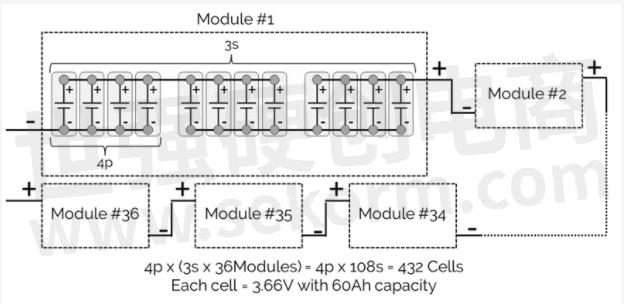
Figure 1: 4p108s Battery Pack Configuration
An EVs battery pack is typically designed for a voltage range between 300V to 450V to balance the energy needs between safety and a component's power handling capability. Higher voltages result in stringent requirements for creepage and air gap distances, and insulation material thickness, and require components capable of withstanding high voltages. Lower voltages require higher currents for the same power resulting in the need for higher gauge conductors that increase the cost and EV weight.
The heart of an electric vehicle is the battery system consisting of a rechargeable lithium-ion battery and a battery management system (BMS) to maximize battery use and safety. The BMS can be defined as any electronic system that manages a rechargeable battery pack by maintaining operation within its safe operating area (SOA), monitoring its state, calculating secondary data, reporting that data, and balancing the individual cell voltages.
A BMS's primary function is to manage the battery state by monitoring its voltage, current, and temperature to keep it operating within its rated safe operating specifications. A battery's state of charge (SOC) and state of health (SOH) calculations are based on monitoring the battery's current consumption profile over time (Figure 2).
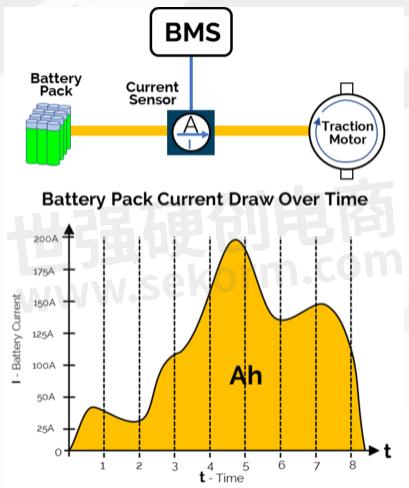
Figure 2: Battery Pack Current Sensing Over Time
Therefore, accurately monitoring a battery's current not only helps extend its operating life and improve driving distance it also alleviates 'range anxiety' by keeping the driver informed on the remaining battery capacity.
A standard coil transformer can accurately measure current, but it is limited to AC current, unusable for an EV battery system that is fundamentally DC. The BMS can only use DC current sensors such as current shunt, Hall effect, or the latest magneto-resistance current sensor, Figure 3.

Figure 3. Types of Current Sensors for EVs
A current shunt is simply a high precision, low value, high power resistor. The battery current is routed through the shunt, which results in a voltage drop proportional to the current. The voltage across the shunt must be amplified, isolated, and measured to derive the proportional current.
The advantage of a current shunt is it doesn't exhibit an offset with no current flow. However, the required isolated amplifier will introduce an offset and the shunt resistor will dissipate power according to the equation P = I2R. As current (I) increases so too does the temperature. Since the resistance values are in the order of a few μΩ, operating temperature variations will slightly change the shunt resistance leading to measurement errors.
A Hall effect sensor detects and measures the magnetic field generated around the current-carrying conductor and outputs a voltage proportional to the current flow. The advantage is that magnetic field sensing by default provides galvanic isolation between the sensor and the battery system. The disadvantages include a high offset (which varies with temperature), nonlinearity, and magnetic hysteresis (large currents in one direction affect the zero offset). As the sensor accuracy degrades the BMS will need to periodically perform calibrations to maintain sensor performance.
magneto-resistance sensors similar to Hall sensors provide contactless current sensing by measuring the magnetic field generated by a current-carrying conductor, Figure 4. The basic principle underlying the Hall effect is the Lorentz force, a Hall plate will output a voltage in the presence of a perpendicular (Z-axis) magnetic field. A magneto-resistance sensor uses the fact that the resistance of a ferromagnetic alloy will change in the presence of a magnetic field. The resistance is smallest when the magnetic field is at a 90-degree angle (Z-axis) and highest when the flux lines are horizontal (X, Y-axis). In general, magneto-resistance sensors have an excellent Signal-to-Noise Ratio (SNR) with higher sensitivity and accuracy than Hall sensors.
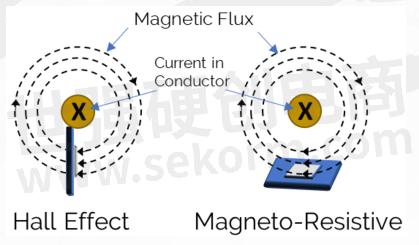
Figure 4: Contactless Current Sensing
These sensors are constructed from resistive ferromagnetic elements configured in a Wheatstone bridge to maximize sensitivity, lower power consumption, minimize thermal instability and achieve better linearity. A magnetic field changes the resistance values causing a bridge imbalance and generating an output voltage proportional to the strength of the magnetic field.
Contactless current sensors will detect magnetic fields from nearby current-carrying conductors, making them susceptible to stray magnetic fields. These stray magnetic fields can be produced by current conductors or inductive motor loads and will contribute a serious source of measurement error unless careful precautions are taken to guard against them.
A popular solution is to shield the sensor with expensive metal alloys having a high magnetic permeability. These costly and bulky alloy shields don’t block or eliminate the magnetic field but instead redirect the field to keep it at a known distance from the sensor. If not properly sized or spaced, this shielding can equally affect the magnetic field generated by the current conductor and therefore has the potential to distort its measurement.
It is more cost-effective and preferable to use a sensor with built-in immunity to external fields. The ideal sensor is constructed with dual sensing elements providing it with built-in common-mode field rejection (CMFR). The current-carrying conductor is routed in such a way that equal and opposite flux lines are generated, and the sense elements (H1 and H2) are positioned in the IC package such that each detects an equal and opposite magnetic field. In this way, any external unipolar field will be canceled out by the dual sensors (Figure 5). The dual sense elements provide high immunity to external magnetic fields removing the need for costly shields.
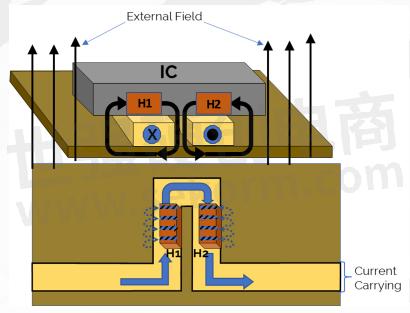
Figure 5: Common Mode Field Rejection (CMFR)
An example of a magneto-resistance sensor is the Crocus Technology CT452. This sensor implements Tunnel Magneto-Resistive (TMR), a new type of magneto-resistance technology. TMR sensors have a fixed magnetic reference layer, an insulator, and a magnetic sensing layer that follows the external field. The orientation of the ferromagnetic layers' magnetization is important so electrons can tunnel across the insulator causing a resistance imbalance in the Wheatstone bridge. The result is a sensor with an inherently good signal-to-noise ratio (SNR) and stability across temperatures.
To optimize performance, the TMR sensor is placed on a busbar and its current sensing range is adjusted using the busbar's cross-sectional dimensions of Length, Width, and Thickness, as well as the air gap distance between the sensor and busbar. The spacing distance between the TMR sensor and the busbar is defined as the 'air gap', minimizing the air gap will increase the sensing range but will also minimize the voltage isolation. The busbar has a slit cut for the purpose of routing the current and enabling a high CMFR as shown in Figure 5.
The sensor can be placed over or under the current carrying busbar and still yield a non-contact and isolated current measurement. Note the busbar top or bottom position relative to the IC will determine the measured current's polarity (Figure 6).
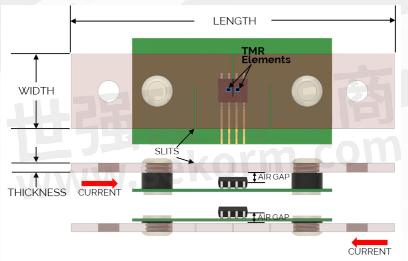
Figure 6: Busbar Positioning
Compared with the traditional shunt and Hall current sensors, the new TMR sensor has a higher SNR, better temperature stability, built-in CMFR, and can be packaged in a smaller area since no shielding is required. The sensed current range can be adjusted by busbar dimensions making it very suitable for a wide range of BMS current requirements in electric vehicles.
Electric vehicles are becoming the norm for electromobility, and their battery power density continues to increase to accommodate a more extended driving range. As the EV battery's maximum current continues to rise, precise measurements require new sensor technology. Traditional current sensors cannot meet the needs for accurate current measurement, high sensitivity, high CMFR, low power, and compact design. Crocus TMR sensors present an improved contactless current sense option for electric vehicle applications.
- |
- +1 赞 0
- 收藏
- 评论 0
本文由Vicky转载自Crocus Technology News,原文标题为:Current Sensing for Electric Vehicles,本站所有转载文章系出于传递更多信息之目的,且明确注明来源,不希望被转载的媒体或个人可与我们联系,我们将立即进行删除处理。
相关推荐
What Is A Current Sensor? What Are The Classifications of Current Sensors?
A sensor is a detection device that can sense the measured information, and can transform the sensed information into electrical signals or other required forms of information output according to certain rules, so as to meet the requirements of information transmission, processing, storage and display. recording and control requirements.
Sensor Technology Helps Electric Vehicle HVAC Systems Meet Air Quality Standards
In electric vehicles, recirculating air presents a bigger challenge, as many EVs use an HVAC system’s recirculation function to maintain efficiency and conserve energy. It takes less energy to heat or cool recirculated air than it does to heat or cool “fresh” outside air using an HVAC system, but those power savings come at a cost to health.
Developing Optimized Sensors with Software for Electric Vehicles
Simulation-based engineering has come a long way and is now an important part of the design process for electric vehicles – sensors included. With software for electric vehicle sensor design and simulations, it’s possible to verify performance and identify potential problems in real-world applications.
Melexis Unveils MLX91235 Current Sensor and Shrinks Current Sensing Footprint with Coreless Technology
Melexis unveils the MLX91235, a new current sensor that eliminates the need for a ferromagnetic core. The MLX91235 expands Melexis‘ portfolio, enabling the measurement of larger currents flowing through external primary conductors like PCB traces and busbars.
EV Battery Pack Water Detection Sensor from Amphenol Sensors
With the sharp growth of electric vehicles, many OEMs are using a water cooling system for the EV battery system. When water escapes the system and leaks into the battery pack, dangerous conditions are created. Amphenol Advanced Sensors‘ Water Detection Sensor monitors for water leakage by constantly checking resistance values. If a leak is detected in the EV battery pack, this sensor technology provides immediate notification.
Melexis Makes a Splash with New Triphibian™ Pressure Sensor MLX90833 Featuring LIN Interface, Which Measuring Pressures Up to 70 Bar
Melexis introduces the MLX90833, a new pressure sensor with Triphibian™ technology, enabling robust measurement of both gas and liquid media from 2 to 70 bar, all within a compact SO16 package.
Amphenol New Sensor Technology Offers Robust Early Detection of Thermal Runaway in Lithium Ion Batteries
Amphenol Advanced Sensors offers a revolutionary new sensor technology for Robust Early Detection of Thermal Runaway (REDTR) to warn of Thermal Runaway by detecting flammable gases vented during Li-ion battery cell failure.
Only TMR Current Sensors Can Enable Efficient Industrial and Automotive Applications
Today, a wide variety of industrial and automotive applications are demanding higher efficiency which impacts many design decisions including the current sensing requirements. The demands are so dramatic that it may be that existing magnetic-based solutions will be obsolete by 2030. These applications demand wide band gap (WBG) power devices pushing the performance requirements for current sensing.
Suncall Corporation Taps Crocus Technologies TMR Sensor Technology to Develop Advanced Sensors for EV Industry
Suncall’s collaboration with Crocus is a significant milestone in the development of the magnetic current sensor. By implementing TMR for current detection applications in devices with high currents, Suncall is breaking new ground in the industry, paving the way for further innovation and growth.
Rotation Angle Sensor (Resolver) for EV/HEV Drive Motor
The VR resolver (rotation angle sensor) is a vital component of the motor that plays a key role in EVs. Over the past half a century, MinebeaMitsumi has cultivated electromagnetic and other resolver technologies through the development and production of aircraft sensors, industrial motors and various rotary components. MinebeaMitsumi supports next-generation eco-friendly cars in the VR resolver that directly affects EVs‘ power consumption rate and driving performance.
NIO Selects Melexis as a Strategic Current Sensor Chip Supplier
NIO, a leading global manufacturer of electric vehicles, selects Melexis‘ state-of-the-art current sensor chips for their traction inverter systems. Melexis‘ chips, well-adapted for the demanding electric motor control environment, will power all of NIO’s battery electric vehicles, underscoring NIO’s dedication to providing innovative, safe, and efficient solutions to their customers.
The lowest power consumption with the smallest size: Terasilic‘s 24GHz radar AiM
The Evs high power consumption problem can be solved by technological innovation -- radar sensors. Terasilic provides customers 24GHz radar AiM (antenna-in-module), the most miniature 24GHz radar sensor with the lowest power consumption in the industry.
What Your Ev Oem Sensor Manufacturer Needs To Know About Your Project
When working with an OEM sensor manufacturer for EVs, essential details to share about the components used in your electric vehicles include:Intended application,Program Timeline,Requirements,Prototypes,Compliance standards.
Melexis Triphibian™ Revolutionizes the World of MEMS Pressure Sensors from Starting the MLX90830
Melexis launches the MLX90830, its first product to feature the new patented TriphibianTM technology. This unprecedented miniaturized MEMS pressure sensor handles gas and liquid media measurement from 2 to 70 bar in a robust way.
What An Established OEM Sensor Manufacturer Does For Ev Production
As the number of electric and hybrid vehicles continues to grow, OEM sensor manufacturers will become an increasingly important part of keeping production lines moving steadily and predictably.
电子商城
品牌:MELEXIS
品类:Integrated Current Sensor IC
价格:¥15.3811
现货: 50,895
品牌:MELEXIS
品类:Triaxis Position Sensor IC
价格:¥22.8370
现货: 29,996
品牌:MELEXIS
品类:Integrated Current Sensor IC
价格:¥14.2165
现货: 23,380
现货市场
品牌:SILICON LABS
品类:Switch Hall Effect Magnetic Position Sensor
价格:¥2.2924
现货:126,000









































































































































































































登录 | 立即注册
提交评论